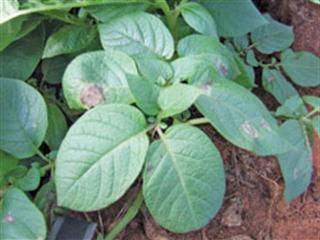
It was this disease which struck the potato crop in Ireland in the mid-1800s, causing a famine that killed a million people and saw a further million people emigrate, mainly to the US.
Late blight originated in Mexico, the area where potatoes originally came from.
The source of the disease is probably where the solution to the disease also lies. There are 25 known potato varieties in Mexico with resistant genes.
Two strains
There are two forms of late blight. The A1 strain is asexually reproduced. The fungus divides to produce a replica which is genetically identical to the original. This means that any variations in the strain would have to come by mutation.
A1 is the strain which we have in South Africa. The ‘advantage’ of this type is that there’s a very slow build-up of resistance to effective fungicides.
The A2 mating strain, meanwhile, can reproduce sexually and even cross with the A1 strain.
This method of reproduction means resistance to fungicides can be built up rapidly. An example of this occurred during the drought of 1976 in Europe, when traders persuaded the authorities to allow the importation of potatoes from Mexico to supplement their shortfall.
With these potatoes came the A2 mating strain, which has subsequently made control of late blight much more difficult and costly. Up to 25 applications of fungicide are needed for control in a single crop.
conditions for infestation
Late blight requires cool, moist weather to develop. To be more precise, there has to be a period of eight to 10 hours of free moisture on the leaf surface for the spores to germinate. The longer it’s wet, the greater the hazard.
I remember many years ago, before the advent of systemic products, I was growing a tomato crop when the weather changed, making it favourable for the development of the disease.
I immediately started to spray the crop, but ran out of fungicide with a small area still to be sprayed. I went to town to purchase some more, then continued spraying. The gap in time was two hours. The area initially sprayed was protected, the second section badly infected. A mere two hours had given the spores enough time to germinate and infect the crop.
systemic products
The situation is much better nowadays, as we have access to systemic products that can stop the fungus even when it’s entered the plant.
But we shouldn’t over-do this, as any resistance build-up would see us lose a valuable weapon in the fight against the disease.
When producing potatoes in conditions where the disease is likely to occur, it’s better to adopt a prophylactic approach.
This involves products which include coppers and dithiocarbimates. These are used to thoroughly wet the foliage and usually afford sufficient protection.
If favourable conditions persist, you still have the back-up of systemic products, which you can apply at first sign of the disease. In areas such as the Highveld, the weather is usually dry and windy in the early season and farmers don’t often do precautionary spraying. But sometimes a cold front comes through, creating favourable conditions for late blight.
I grew up with late blight and can sense when conditions are favourable for it to occur, and often phone clients to warn them to spray.
If the weather is right, but you’re unsure you’re dealing with late blight, place the blemished foliage in a bottle with moist paper or cotton wool and seal with a lid. If it’s late blight you’ll see a mass of grey fungus the following day.
I assume it’s called ‘late blight’ due to the weather being more suitable for the disease in the late season, when you’ll also have higher spore counts in the air.
Certainly, late blight is more likely to occur in the late season in South Africa, and in vulnerable areas it would be wise to select potato varieties with genetic resistance. These have the prefix ‘BP’, as in ‘BP 1’.
Contact Bill Kerr at [email protected]. Please state ‘Vegetable production’ in the subject line of your email.











